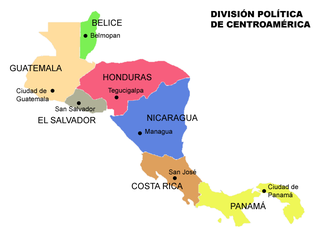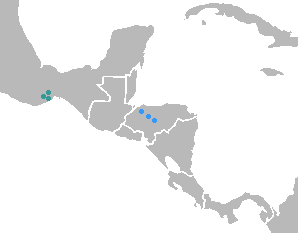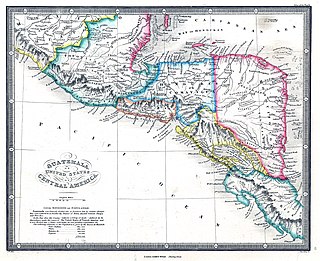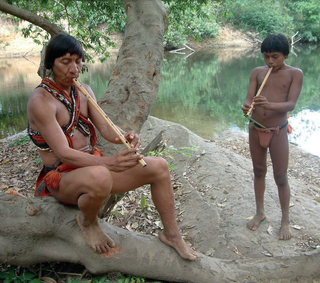
This article is about the ethnic groups and population of Honduras.

Francisco Morazán is one of the departments of Honduras.

Anne MacKaye Chapman was a Franco-American ethnologist who focused on the people of Mesoamerica writing several books, co-producing movies, and capturing sound recordings of rare languages from the Northern Triangle of Central America to Cape Horn in South America.

Central America is a subregion of the Americas formed by six Latin American countries and one (officially) Anglo-American country, Belize. As an isthmus it connects South America with the remainder of mainland North America, and comprises the following countries : Belize, Guatemala, Honduras, El Salvador, Nicaragua, Costa Rica, and Panama.

Hondurans are the citizens of Honduras. Most Hondurans live in Honduras, although there is also a significant Honduran diaspora, particularly in the United States, Spain, and many smaller communities in other countries around the world.
Cuncos, Juncos or Cunches is a poorly known subgroup of Huilliche people native to coastal areas of southern Chile and the nearby inland. Mostly a historic term, Cuncos are chiefly known for their long-running conflict with the Spanish during the colonial era of Chilean history.

Tolatecan is a proposal by Campbell and Oltrogge (1980) linking two language families of Mesoamerica, Tequistlatecan and Tol/Jicaque languages of Honduras. Later, Campbell (1997) said that Tolatecan is not likely to be a valid language family.
Tol (Tolpan), also known as Eastern Jicaque, Tolupan, and Torupan, is spoken by approximately 500 Tolupan people in La Montaña de la Flor reservation in Francisco Morazán Department, Honduras.

The Province ofTaguzgalpa, also called New Cartago, was created by Royal Order of February 10, 1576. The entire province stretched from east of Trujillo, or the Aguan or Roman River, as far as the San Juan River, but was believed to be only from the east of Trujillo to the Wanks or Coco River. It also included the Province of Tologalpa, which stretched from the Coco River to the San Juan River. It was bordered to the north and east by the Caribbean Sea; by the south by the Province of Costa Rica; and by the west by the Province of Honduras and Province of Nicaragua. It appeared on the Dutch map of Montanus in 1671 with an alternate spelling of "Tiguzigalpa."
The Andaquí are an indigenous people of Colombia, who live in the Upper Caquetá River Basin, the Fragua Valley of Cauca Department, and the Suaza Valley of southwest Huila Department.

The Lakandon Chʼol were a former Chʼol-speaking Maya people inhabiting the Lacandon Jungle in what is now Chiapas in Mexico and the bordering regions of northwestern Guatemala, along the tributaries of the upper Usumacinta River and the foothills of the Sierra de los Cuchumatanes.

Tisquesusa, also spelled Thisquesuza, Thysquesuca or Thisquesusha was the fourth and last independent ruler (psihipqua) of Muyquytá, main settlement of the southern Muisca between 1514 and his death in 1537. The Spanish pronunciation of his name brought about the Colombian capital Bogotá. Tisquesusa was the ruler of the southern Muisca Confederation at the time of the Spanish conquest of the Muisca, when the troops led by Gonzalo Jiménez de Quesada and his brother entered the central Andean highlands.

Jorge Augusto Gamboa Mendoza is a Colombian anthropologist and historian. He has been contributing on the knowledge of Hispanic and pre-Hispanic territories of what is now Colombia, especially the Muisca. Jorge Gamboa speaks Spanish and French.

Carl Henrik Langebaek Rueda is a Colombian anthropologist, archaeologist and historian. He has been contributing on the knowledge of archaeological evidences, especially the Herrera Period and the Muisca. Langebaek was vice-chancellor for academic affairs at Universidad de los Andes and speaks Spanish and English.

Honduras has rich folk traditions that derive from the fusion of four different cultural groups: indigenous, European, African and Creole. Each department or region, municipality, village and even hamlet contributes its own traditions including costumes, music, beliefs, stories, and all the elements that derive from and are transformed by peoples in a population. In sum, these define Honduran Folklore as expressed by crafts, tales, legends, music and dances.

Intibucá is a city, with a population of 28,220, and a municipality in the department of Intibucá, Honduras. The urban area of Intibucá is an important transit and commercial site in the South-West region of Honduras. Located 1,850 meters above sea level, Intibucá has a cool and often foggy climate, hence the nickname "La ciudad del manto blanco". Potato production, celebrated by the annual Festival de la Papa, is the principal basis of the economy for the municipality.

María Teresa Rojas Rabiela is an ethnologist, ethnohistorian, Emeritus National Researcher and Mexican academic, specializing in Chinampas of Mexico's Basin, history of agriculture, hydraulics, technology, and labor organization in Mesoamerica during pre-Columbian and colonial eras, as well as historical photography of Mexico's peasants and indigenous people. She is recognized as a pioneer in historical studies on earthquakes in Mexico. From 2018 to 2021, Rojas Rabiela was involved in the restoration of the section of the pre-Hispanic aqueduct of Tetzcotzinco, Texcoco, known as El caño quebrado.

Audencio “Leckott” Zamora is a writer, musician, journalist, cultural model and artisan of the Wichí people. He lived many years in Venezuela and currently resides in Puerto Tirol, Chaco Province. He has written several books about Wichí culture, and helped in several newspaper and scientific articles related to the rights, health and education of indigenous peoples.

The Hodï or Jotï are a small group of indigenous people who live in the Amazon rainforest in Venezuela. The last census held in Venezuela, in 2011, registered 982 individuals identifying as Hodï; a 2016 estimate accounted a population of around 1200. They speak the Hodï language and are closely related to the Piaroa people, although linguistic connections between the two people groups have not reached consensus among scholars. They are also known by a number of exonyms as the Hoti, Chicano, Shikana, Yuana, Waruwarú, or Rua.
















